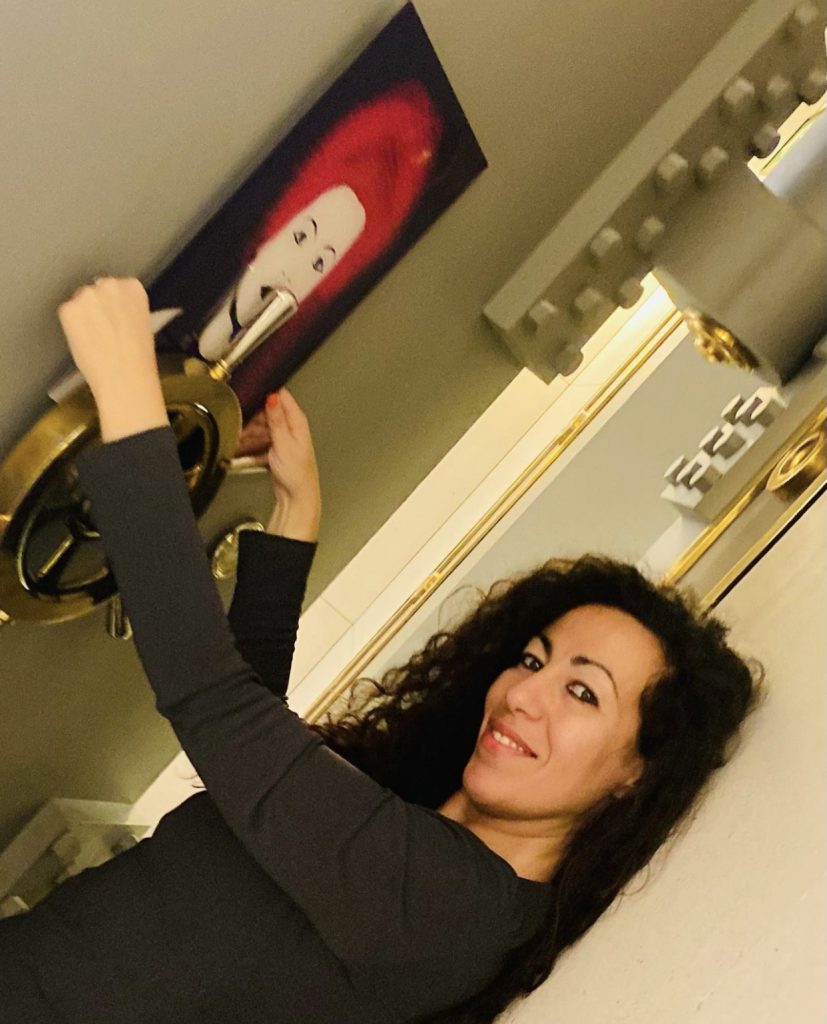Houda Bakkali is an award-winning visual artist. She is an expert in new technologies applied to art. She started her artistic career in 2008 and since then her art has been exhibited in public and private events and institutions worldwide. She has created some of the most pioneering immersive and digital exhibitions in public spaces such as airports and cultural centres. She has exhibited at Madrid Adolfo Suárez Madrid Barajas International Airport and Málaga-Costa del Sol International Airport, these solo exhibitions were the first ever events to combine large format mixed media canvases, augmented reality, immersive experiences and the female figure as protagonist in these airports. Houda Bakkali exhibited the first augmented reality canvas at the First Contemporary Art Salon in Monte-Carlo, Monaco, celebrated in 2020, as well as her first immersive AR canvas in Sanremo, Italy, 2020.
She has developed a global and pioneering project on digital art, augmented reality, audiovisual content and virtual workshops on new technologies in 6 Civic Centers of Barcelona City Council with the female figure as the protagonist. She also developed the first ever extended reality project on Don Quixote, the most universal literary book. Her digital art has been exhibited and presented at Paradores, Soria Provincial Council, Sanremo Museo dei Fiori (Italy), Casinó di San Remo (Italy), the iconic Reial Cercle Artistic de Barcelona, L’Alliance Française and at various international festivals and private events.
A pioneer in digital art and new technologies, Houda Bakkali has been sharing her work through iconic public and private institutions worldwide for many years, combining her creativity with her educational work based on conferences, workshops and masterclasses on new technologies and art. Since 2009, Houda has been developing an educational and informative project on communication and health, highlighting the effectiveness of combining art, technology and communication.
Houda has won three American Illustration awards (New York). She won the International Motion Award (New York) and the New Talent Award at the International Festival Artists of the World in Cannes. Her art has also been recognised by the London International Creative, the Paris Design Award, the Creative Quarterly (New York), four Graphis Silver Awards (New York), among others distinctions, and she was selected by the iconic TIME magazine for its first artistic web3 initiative.
Her creative process is dynamic and is based on canvas, animation, augmented reality, virtual and immersive spaces. Her art seeks to exemplify the power of digital art to transcend spatial, temporal and generational boundaries, creating synergies between different audiences and making art not only timeless, but also universal, accessible and understandable, believing in the power of art to unite and create a friendlier, more fun and creative space.
Houda Bakkali’s creative concept focuses on optimism, colourful environments and hopeful messages. The flowers, polka dots and feminine looks invite us to paint a future of fulfilled dreams. Her art speaks of the future and joy.

REVIEW BY JULIET ART MAGAZINE | ITALY, 2020
The style of Houda Bakkali is unmistakable and derives from a sophisticated and often ironic mimesis of the popular contents of the urban environment, reworked through a lively chromatic pop range and an elegant and essential design. The artist seems to consider the urban scene as a festive visual spectacle in which the images imply a multiplicity of messages, of logical, emotional and symbolic meanings: metropolitan details coming from different cultures flow into her works, unexpectedly merging into a new balance without generating conflicts. If the 60s Pop Art turned its investigation to the complex and multiform panorama of the great western metropolises with the intent to carry out an irreverent reconnaissance of mass culture, Houda Bakkali widens the field of investigation to a sort of extended macro continent that reflects in a more updated way the new integrated topography of the world, increasingly founded on inevitable mutual implications.
Her language shares with the “historical” Pop Art the intent to arouse in the viewer an immediate response and the awareness that the multi-faceted cultural horizon in which we find ourselves living is a reality that cannot be evaded or denied, but must be investigated and understood in its formative factors and in the interconnections that animate its dynamics. In recent decades, society has profoundly changed: well-being, which for some time seemed to be within everyone’s reach, has revealed its prevaricating background against the environment and the populations where mass production has been displaced.
Values have changed, today increasingly in tension between the two opposite poles of ideology and total dissolution, the vision of the world has changed, which oscillates vertiginously between bewilderment and a childish individualistic narcissism. In such a heterogeneous context it is very easy to lose orientation and not be able to find a coherent and not partial reading key to the world around us.
